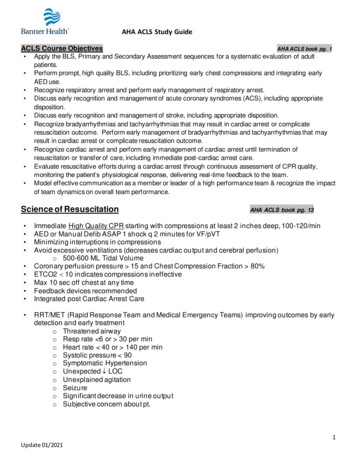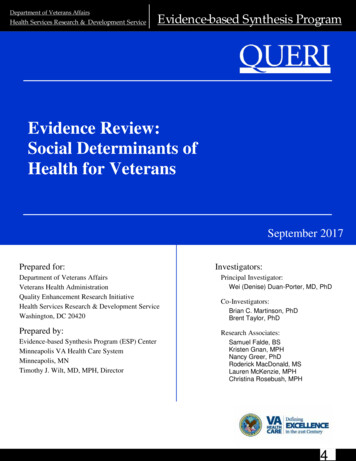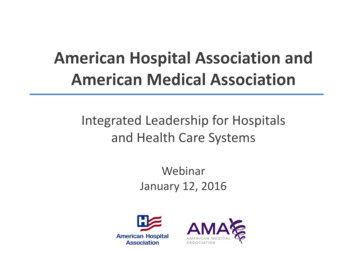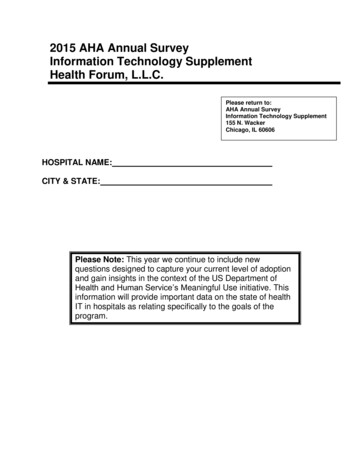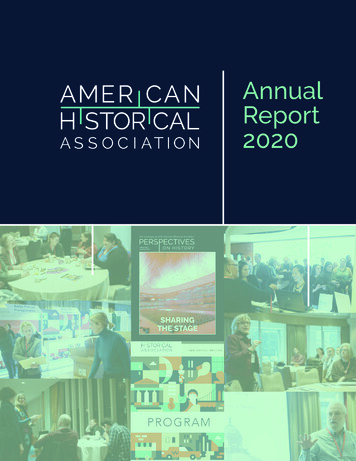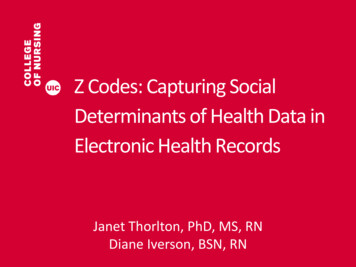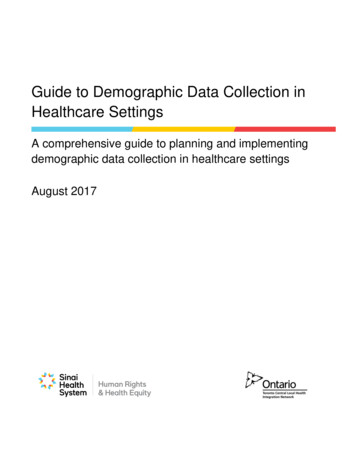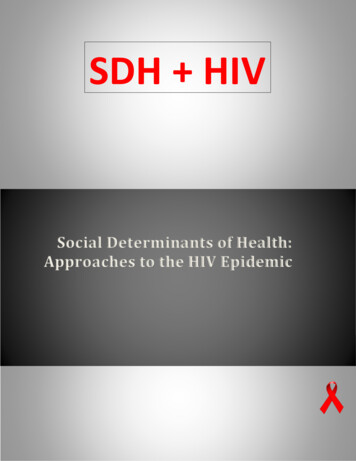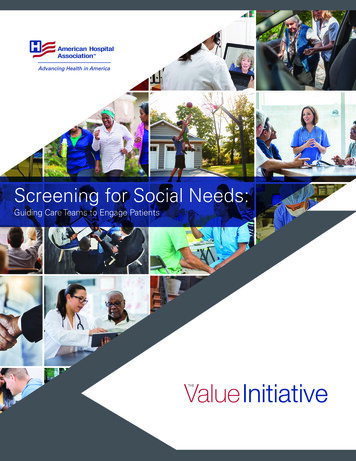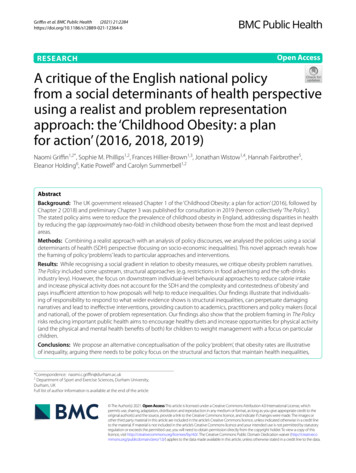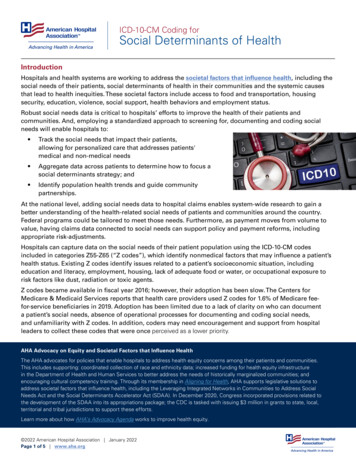
Transcription
ICD-10-CM Coding forSocial Determinants of HealthIntroductionHospitals and health systems are working to address the societal factors that influence health, including thesocial needs of their patients, social determinants of health in their communities and the systemic causesthat lead to health inequities. These societal factors include access to food and transportation, housingsecurity, education, violence, social support, health behaviors and employment status.Robust social needs data is critical to hospitals’ efforts to improve the health of their patients andcommunities. And, employing a standardized approach to screening for, documenting and coding socialneeds will enable hospitals to: Track the social needs that impact their patients,allowing for personalized care that addresses patients'medical and non-medical needs Aggregate data across patients to determine how to focus asocial determinants strategy; and Identify population health trends and guide communitypartnerships.At the national level, adding social needs data to hospital claims enables system-wide research to gain abetter understanding of the health-related social needs of patients and communities around the country.Federal programs could be tailored to meet those needs. Furthermore, as payment moves from volume tovalue, having claims data connected to social needs can support policy and payment reforms, includingappropriate risk-adjustments.Hospitals can capture data on the social needs of their patient population using the ICD-10-CM codesincluded in categories Z55-Z65 (“Z codes”), which identify nonmedical factors that may influence a patient’shealth status. Existing Z codes identify issues related to a patient’s socioeconomic situation, includingeducation and literacy, employment, housing, lack of adequate food or water, or occupational exposure torisk factors like dust, radiation or toxic agents.Z codes became available in fiscal year 2016; however, their adoption has been slow. The Centers forMedicare & Medicaid Services reports that health care providers used Z codes for 1.6% of Medicare feefor-service beneficiaries in 2019. Adoption has been limited due to a lack of clarity on who can documenta patient’s social needs, absence of operational processes for documenting and coding social needs,and unfamiliarity with Z codes. In addition, coders may need encouragement and support from hospitalleaders to collect these codes that were once perceived as a lower priority.AHA Advocacy on Equity and Societal Factors that Influence HealthThe AHA advocates for policies that enable hospitals to address health equity concerns among their patients and communities.This includes supporting: coordinated collection of race and ethnicity data; increased funding for health equity infrastructurein the Department of Health and Human Services to better address the needs of historically marginalized communities; andencouraging cultural competency training. Through its membership in Aligning for Health, AHA supports legislative solutions toaddress societal factors that influence health, including the Leveraging Integrated Networks in Communities to Address SocialNeeds Act and the Social Determinants Accelerator Act (SDAA). In December 2020, Congress incorporated provisions related tothe development of the SDAA into its appropriations package; the CDC is tasked with issuing 3 million in grants to state, local,territorial and tribal jurisdictions to support these efforts.Learn more about how AHA’s Advocacy Agenda works to improve health equity. 2022 American Hospital Association January 2022Page 1 of 5 www.aha.org
Coding GuidanceThe AHA offers members tools and resources to increaseutilization of Z codes. The AHA Coding Clinic has provided furtherclarification on the appropriate documentation and use of Z codesto enable hospitals to incorporate them into their processes.Any clinician can document a patient’s social needs. Codesfrom categories Z55-Z65 can be assigned based on informationdocumented by all clinicians involved in the care of thepatient. The AHA Coding Clinic clarified that for the purposeof documenting social information, “clinicians” can includeanyone deemed to meet the requirements, set by regulationor internal hospital policy, to document in the patient’s official medical record. This means that in manycases, coding professionals can utilize documentation of social needs from clinicians including, but notlimited to, nonphysician providers, such as social workers, community health workers, case managers,nurses or other providers.For example, Sharp Grossmont Hospital’s Care Transitions Intervention Program deploys a multidisciplinarycare team to conduct comprehensive risk assessments that screen patients for clinical and social risks. Thatcare team includes nurses, case managers and social workers. And Baylor Scott & White Health’s CommunityAdvocate Program trains college volunteers to conduct social needs screenings and connect patientswith appropriate services and resources. In both examples, provided these individuals were deemedappropriate to document this information in the patient’s medical record, that documentation wouldsupport the use of a Z code.Patient self-reported social needs. Hospitals often utilize patient self-report tools to identify social needs. Ifthe patient self-reported information is signed-off and incorporated into the medical record by a clinician,that information can support the use of a Z code by coding professionals. For example, IHA/Trinity Healthdeveloped a self-report screening tool in English, Spanish and Arabic that is integrated with the electronichealth record, enabling the health system to track responses, refer patients to community resources andfollow up after their visit. Because that information is incorporated into the electronic health record, thatinformation can support the use of a Z code.Additional Information on CodingFor more information on coding guidelines, contact Nelly Leon-Chisen, RHIA, AHA director of coding andclassification, at nleon@aha.org and visit codingclinicadvisor.com.What You Can Do1Hospital leaders should educate key stakeholders, including physicians, nonphysician health careproviders and coding professionals of the important need to screen, document and code data onpatients’ social needs. Utilizing Z codes will allow hospitals and health systems to better track socialneeds and identify solutions to improve the health of their patients and communities.2As coding professionals review a patient’s medical record to identify the appropriate ICD-10-CMcodes to include, they should be aware of and begin utilizing the ICD-10-CM codes included incategories Z55-Z65, listed in Table 1.3Hospital leaders can prioritize the importance of documenting and coding patients’ social needs andallow coders extra time to integrate coding for social determinants into their processes. 2022 American Hospital Association January 2022Page 2 of 5 www.aha.org
Table 1ICD-10-CM Code CategoriesICD-10-CM Code CategoryProblems/Risk Factors Included in CategoryZ55 – Problems related toeducation and literacyIlliteracy, schooling unavailable, underachievement in a school, less than a high schooldiploma, no general equivalence degree (GED), educational maladjustment, and discord withteachers and classmates.Z56 – Problems related toemployment and unemploymentUnemployment, change of job, threat of job loss, stressful work schedule, discord with bossand workmates, uncongenial work environment, sexual harassment on the job, and militarydeployment status.Z57 – Occupational exposure torisk factorsOccupational exposure to noise, radiation, dust, environmental tobacco smoke, toxic agentsin agriculture, toxic agents in other industries, extreme temperature, and vibration.Z58 – Problems related tophysical environmentInadequate drinking-water supply, and lack of safe drinking water.Z59 – Problems relatedto housing and economiccircumstancesSheltered homelessness, unsheltered homelessness, residing in street, inadequate housing,housing instability, discord with neighbors, lodgers and landlord, problems related to livingin residential institutions, inadequate food, lack of adequate food, food insecurity, extremepoverty, low income, and insufficient social insurance and welfare support.Z60 – Problems related to socialenvironmentAdjustment to life-cycle transitions, living alone, acculturation difficulty, social exclusion andrejection, target of adverse discrimination and persecution.Z62 – Problems related toupbringingInadequate parental supervision and control, parental overprotection, upbringing away fromparents, child in welfare custody, institutional upbringing, hostility towards and scapegoatingof child, inappropriate excessive parental pressure, personal history of abuse in childhood,personal history of neglect in childhood, personal history of unspecified abuse in childhood,parent-child conflict, and sibling rivalry.Z63 – Other problems related toprimary support group, includingfamily circumstancesAbsence of family member, disappearance and death of family member, disruption of familyby separation and divorce, dependent relative needing care at home, stressful life eventsaffecting family and household, stress on family due to return of family member from militarydeployment, and alcoholism and drug addiction in family.Z64 – Problems relatedto certain psychosocialcircumstancesUnwanted pregnancy, multiparity, and discord with counselors.Z65 – Problems related to otherpsychosocial circumstancesConviction in civil and criminal proceedings without imprisonment, imprisonment and otherincarceration, release from prison, other legal circumstances, victim of crime and terrorism,and exposure to disaster, war and other hostilities. 2022 American Hospital Association January 2022Page 3 of 5 www.aha.org
AHA Resources onSocietal Factors that Influence HealthThe AHA offers a range of tools and resources for hospitals, health systems and clinicians that address the societal factors thatinfluence health and improve health equity.Issue Briefs and GuidesSocietal Factors That Influence Health FrameworkThis framework is designed to guide hospitals’ strategies to address the social needs of their patients, socialdeterminants of health in their communities and the systemic causes that lead to health inequities so the entirefield can have meaningful conversations around these issues.Community Investment for HealthHospitals and health systems are adopting place-based investment strategies to address housing insecurityand other societal factors that influence health. These tools and resources explore how hospitals can improveindividual and community well-being, advance health equity and create more resilient communities.Screening for Social Needs:Guiding Care Teams to Engage Patients1 2019 American Hospital Association www.aha.orgScreening for Social Needs: Guiding Care Teams to Engage PatientsThis tool helps hospitals and health systems facilitate sensitive conversations with patients about theirnonmedical needs that may be a barrier to good health. It includes strategic considerations for implementing ascreening program, tips for tailoring screenings to hospitals’ unique communities, case examples and a list ofnational organizations that can help connect patients with local resources.Housing and Health: A Roadmap for the FutureThis tool shares strategic considerations for how hospitals and health care systems can tailor a housingstrategy to meet community needs and case examples of how hospitals are addressing housing instability.Social Determinants of Health GuidesAHA is producing a series of guides on how hospitals can address various social determinants of health.Below are the topics covered to date:Food Insecurity and the Role of HospitalsTransportation and the Role of HospitalsHousing and the Role of HospitalsPromoting Healthy BehaviorsConnecting the Dots: Value and Health Equity.This issue brief from AHA’s The Value Initiative frames the connection between equity and value andaffordability, highlighting how hospitals can improve value by addressing social determinants of health and equity.Podcasts and WebinarsUsing Z Codes to Address Patient Needs. This podcast discusses the benefits of using Z codes.ICD-10-CM Codes for the Social Determinants of Health. This webinar examines why and how hospitalsshould adopt Z codes as part of their health equity strategies.A podcast from theAmerican HospitalAssociation 2022 American Hospital Association January 2022Page 4 of 5 www.aha.org
Affiliate GroupsInstitute for Diversity and Health EquityThe Institute works closely with health care organizations to advance healthequity for all and to expand leadership opportunities for ethnic minorities inhealth management.AHA Community Health ImprovementACHI provides educational resources and tools, professional development andnetworking opportunities to help health leaders expand their knowledge andenhance their performance in achieving community health goals.AHA Physician AllianceThe AHA Physician Alliance supports physician leaders in improving care fortheir communities and helps clinical and administrative leadership collaborateeffectively. Their Social Determinants of Health Curriculum for Clinicians helpsproviders address social determinants via a web-based virtual expedition to trainand equip staff with how-to actions and companion resources.Trustee ServicesAHA Trustee Services serves as the hub for the association’s efforts to helpgovernance boards navigate the transforming health care landscape. It offersnumerous resources on diversity, equity and inclusion.Other ResourcesCMS Office of Minority Health: The InfographicUsing Z Codes: The Social Determinants of Health Data Journey to BetterOutcomes, outlines steps to collect, report and use Z codes. It also offersdirectives specific to hospital administrators, coding professionals andproviders regarding Z codes. 2022 American Hospital Association January 2022Page 5 of 5 www.aha.org
2022 American Hospital Association January 2022 Page 1 of 5 www.aha.org Social Determinants of Health ICD-10-CM Coding for Introduction Hospitals and health systems are working to address the societal factors that influence health, including the social needs of their patients, social determinants of health in their communities and the systemic causes
